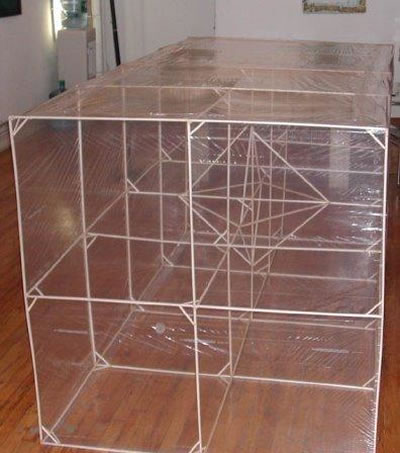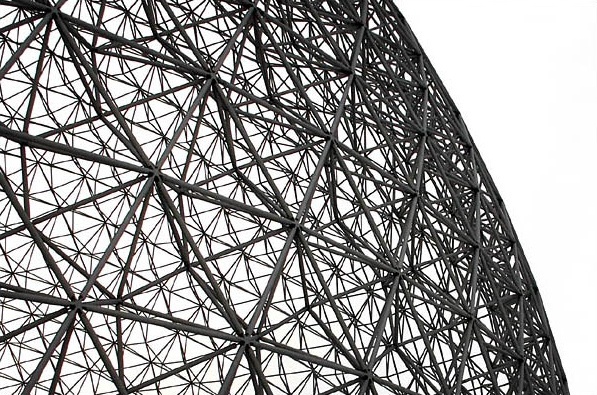Vacuum Balloon
- Lentamentalisk
- Sergeant 3

- Posts: 1202
- Joined: Tue Aug 07, 2007 5:27 pm
- Location: Berkeley C.A.
Carbon fiber would not help. Carbon fiber has a particularly high tensile strength, but not a very high compressive strength. Thats the idea with styrofoam. Its generally pretty good at resisting compression.
For certain, it wouldn't be practical on a small scale. But then again, anything smaller than a 9" helium balloon isn't particularly practical either.
The larger the balloon, the greater the volume to surface area ratio, so eventually it could get to equilibrium.
The trick is going to be figuring out an equation for the thickness required of styrofoam to resist 10-15psi, at a given diameter, and see when that intersects with the buoyancy.
Chances are, that point will be somewhere in the hundreds or thousands of feet in diameter, where other forces start playing in as well, but its worth a try.
Also, its possible that other styrofoam-like materials would be better suited for this project. Blowing the styrofoam with helium, for example, could slightly reduce the density.
For certain, it wouldn't be practical on a small scale. But then again, anything smaller than a 9" helium balloon isn't particularly practical either.
The larger the balloon, the greater the volume to surface area ratio, so eventually it could get to equilibrium.
The trick is going to be figuring out an equation for the thickness required of styrofoam to resist 10-15psi, at a given diameter, and see when that intersects with the buoyancy.
Chances are, that point will be somewhere in the hundreds or thousands of feet in diameter, where other forces start playing in as well, but its worth a try.
Also, its possible that other styrofoam-like materials would be better suited for this project. Blowing the styrofoam with helium, for example, could slightly reduce the density.
Do not look back, and grieve over the past, for it is gone;
Do not be troubled about the future, for it has not yet come;
Live life in the present, and make it so beautiful that it will be worth remembering.
Do not be troubled about the future, for it has not yet come;
Live life in the present, and make it so beautiful that it will be worth remembering.
No... that would be 1 metre radius. But for a 1 metre radius sphere, your maths is entirely correct - the foam would be less than 3mm thick, and that's just not going to support those kinds of forces.jackssmirkingrevenge wrote:Let's go with a 1 metre diameter sphere.
If the total weight is more than 5kg, it won't float.
The problem here is coping with HUGE forces, yet minimal weight. Even under ideal circumstances, you can't use more than about 1.2 grams per litre of air displaced. It may be possible with the right materials. - but I doubt that it can be done on any kind of sane budget.
Does that thing kinda look like a big cat to you?
Thinking of model planes, alot of them are made up of a balsa airframe with tissue or plastic stretched around it. make a frame with good quality hobby grade balsa which can have a very low density put some strong lightweight material around it (search rc forums for that) I haven't got to the stage in maths most of you guys have.
http://www.go-cl.se/balsa.html
This is a really interesting page that has compression strengths ect.
http://www.go-cl.se/balsa.html
This is a really interesting page that has compression strengths ect.
I visit occasionally to make unrelated posts.
- POLAND_SPUD
- Captain

- Posts: 5402
- Joined: Sat Oct 13, 2007 4:43 pm
- Been thanked: 1 time
@qwerty
pressure = force X surface
so 15psi = 15 pounds per square inch (OH RLY? )
)
if you've got a 4" by 4" piece of plastic sheet we're talking about 240 pounds... and that's with just 4" by 4"
Have you ever how much pressure you need to destroy your house ?? don't worry - it has been tested
http://en.wikipedia.org/wiki/Little_Boy#Blast
pressure = force X surface
so 15psi = 15 pounds per square inch (OH RLY?
if you've got a 4" by 4" piece of plastic sheet we're talking about 240 pounds... and that's with just 4" by 4"
Have you ever how much pressure you need to destroy your house ?? don't worry - it has been tested
http://en.wikipedia.org/wiki/Little_Boy#Blast
Children are the future
unless we stop them now
unless we stop them now
- Technician1002
- Captain

- Posts: 5189
- Joined: Sat Apr 04, 2009 11:10 am
The major difficulties lie in the sphere. A small sphere can have a thin shell due to the radius of the curve. A small sphere has small volume and thus low buoyancy.
A large sphere encounters the difficulties of a large surface that is almost flat. The problem now becomes a large flat surface with a huge surface area and the resulting huge force. Preventing failure without adding huge mass becomes the problem.
How would you build flat wall 10 feet square to hold the force. The requirements for strength go up drastically with diameter. How thick of a Styrofoam wall will hold a vacuum on one side?
15 PSI
144 square inches per square foot
100 square feet.
2160 pounds per square foot
216,000 pounds per section 10 feet by 10 feet.
Somehow I don't think Styrofoam will hold it.
I rounded the pressure to 15 PSI. The actual numbers are slightly less at sea level. If you can build a Styrofoam self supporting dome to span 10 feet that will support 100 tons, I'd love to see it.
A large sphere encounters the difficulties of a large surface that is almost flat. The problem now becomes a large flat surface with a huge surface area and the resulting huge force. Preventing failure without adding huge mass becomes the problem.
How would you build flat wall 10 feet square to hold the force. The requirements for strength go up drastically with diameter. How thick of a Styrofoam wall will hold a vacuum on one side?
15 PSI
144 square inches per square foot
100 square feet.
2160 pounds per square foot
216,000 pounds per section 10 feet by 10 feet.
Somehow I don't think Styrofoam will hold it.
I rounded the pressure to 15 PSI. The actual numbers are slightly less at sea level. If you can build a Styrofoam self supporting dome to span 10 feet that will support 100 tons, I'd love to see it.
- Fnord
- First Sergeant 2

- Posts: 2239
- Joined: Tue Feb 13, 2007 9:20 pm
- Location: Pripyat
- Been thanked: 1 time
- Contact:
Maybe a perfect 2m diameter, 2mm thick sphere of pure diamond would do it with reasonable lifting power and safety factor. But unless you've got a jar of nanite assemblers on your shelf I think tension load is the best way to do it.
Carbon fiber, specta and kevlar are easy to work with and not extremely expensive, but when you use them in compression you're always limited by the strength of the matrix you suspend them in. If you can find an extremely hard substance that can be liquified or melted without enough heat to degrade carbon fiber then it may be plausible. Also, any slight deformity in the sphere will probably cause a failure.
I think an internal framework underneath some type of flexible fiber-reinforced cloth work be your best bet.
3 rods of heat-treated tool steel arranged in an x,y,z axis shape with a strong membrane of some sorts stretched tightly over their points may be feasible.
Carbon fiber, specta and kevlar are easy to work with and not extremely expensive, but when you use them in compression you're always limited by the strength of the matrix you suspend them in. If you can find an extremely hard substance that can be liquified or melted without enough heat to degrade carbon fiber then it may be plausible. Also, any slight deformity in the sphere will probably cause a failure.
I think an internal framework underneath some type of flexible fiber-reinforced cloth work be your best bet.
3 rods of heat-treated tool steel arranged in an x,y,z axis shape with a strong membrane of some sorts stretched tightly over their points may be feasible.

- jackssmirkingrevenge
- Five Star General

- Posts: 26179
- Joined: Thu Mar 15, 2007 11:28 pm
- Has thanked: 543 times
- Been thanked: 321 times
One thing we're all assuming is a full vacuum, ie 14.7 psi outside and zero inside. With a partial vacuum, you'd still be losing density while reducing the requirement for structural strength...

This one is rather silly having flat sides, but the idea is there...

This one is rather silly having flat sides, but the idea is there...
hectmarr wrote:You have to make many weapons, because this field is long and short life
I don't quite get why you said that but what i meant is basicly JSR's ideapressure = force X surface
so 15psi = 15 pounds per square inch (OH RLY? Very Happy)
if you've got a 4" by 4" piece of plastic sheet we're talking about 240 pounds... and that's with just 4" by 4"
I visit occasionally to make unrelated posts.
Hmm... That reminds me. For a school technology project, all of my class once had to put together matchstick towers. 200 matchsticks or less that could support a weight at least... I don't know, something like 6 to 10 inches off the floor.jackssmirkingrevenge wrote:This one is rather silly having flat sides, but the idea is there...
I won that particular competition, given that my tower supported several times the weight its competitors could. Most people managed a few kilos before collapse. I managed to beat even the teacher's example (and he had been doing it quite some time) by standing all 70 kilos of myself on top of the thing. And I'd used less than half the matchsticks I was allowed.
... so yes, I'm awesome. :tongue3:
Hmm. With that in mind, maybe this IS doable. If you use them right, you can to push some materials to extremes that seem almost impossible.
Does that thing kinda look like a big cat to you?
- Technician1002
- Captain

- Posts: 5189
- Joined: Sat Apr 04, 2009 11:10 am
I was playing with a geodesic sphere, but with a center hub with spokes to each vertices's and the outside a sphere so the struts only have compression stress. Each surface segment might be built strong and lightweight enough to do it. I haven't done the area per segment for the pentagons and hexagons yet to see if this is even a possibility. Built with a two layer dome, the added advantage of an internal truss adds rigidity to the struts.jackssmirkingrevenge wrote:One thing we're all assuming is a full vacuum, ie 14.7 psi outside and zero inside. With a partial vacuum, you'd still be losing density while reducing the requirement for structural strength...
This one is rather silly having flat sides, but the idea is there...

- jackssmirkingrevenge
- Five Star General

- Posts: 26179
- Joined: Thu Mar 15, 2007 11:28 pm
- Has thanked: 543 times
- Been thanked: 321 times
hectmarr wrote:You have to make many weapons, because this field is long and short life
-
jimmy101
- Sergeant Major


- Posts: 3197
- Joined: Wed Mar 28, 2007 9:48 am
- Location: Greenwood, Indiana
- Has thanked: 5 times
- Been thanked: 15 times
- Contact:
The challenge is that even though a given vacuum volume would have a slightly greater lift than helium or hydrogen the two lighter than air gases place almost zero stress on the envelope. A hydrogen balloon is pressurized to basically 1 atmosphere and there is very little net force on the envelope, just the lifting forces. Using vacuum you've got 14.7 PSIA on the envelope so nothing light will work as the balloon.
14.7 PSIA isn't all that great a pressure, at least it isn't until you consider that weight is the big problem. A chamber that'll hold the pressure load isn't going to be light enough. A cubic meter of vacuum will only lift about 1.3KG (35 cubic feet, 2.9 pounds).
The additional lift you would get with vacuum versus say hydrogen is pretty minimal. For that small increase in lift you get a huge penalty in the mass of the envelope. A vacuum balloon will lift 1.3Kg/L<sup>3</sup>, an H<sub>2</sub> balloon will lift (1.3)(2/29)=1.2Kg/L<sup>3</sup> that's ~92 percent of the lifting capacity of the vacuum balloon without all the added weight.
14.7 PSIA isn't all that great a pressure, at least it isn't until you consider that weight is the big problem. A chamber that'll hold the pressure load isn't going to be light enough. A cubic meter of vacuum will only lift about 1.3KG (35 cubic feet, 2.9 pounds).
The additional lift you would get with vacuum versus say hydrogen is pretty minimal. For that small increase in lift you get a huge penalty in the mass of the envelope. A vacuum balloon will lift 1.3Kg/L<sup>3</sup>, an H<sub>2</sub> balloon will lift (1.3)(2/29)=1.2Kg/L<sup>3</sup> that's ~92 percent of the lifting capacity of the vacuum balloon without all the added weight.

- Skywalker
- Specialist


- Posts: 194
- Joined: Sun Aug 05, 2007 7:22 pm
- Has thanked: 9 times
- Been thanked: 9 times
Well, being a physicist, I have to chime in:
The optimal vacuum balloon is a spherical metal shell. If I did the math right, the lifting capacity is given by L=L_0*(1-1.5*R*P) where L_0 is the ideal lifting capacity (ie, volume*density of air displaced), R=(rho_m/rho_a-1), (rho_a=density of air, rho_m is for the metal), and P=P_a/S, where S is the compressive strength of the metal, P_a is the air pressure. (This equation assumes that the spherical shell is as thin as the compressive strength of the metal will allow. Thus, it turns out that the radius of the shell is irrelevant. Of course, it may be that the shell will buckle -- I'm not an engineer, I don't know how to treat that.)
For aircraft grade aluminum at sea level, I get L/L_0=.395, or basically only 40% of the ideal vacuum buoyancy. Titanium alloy is about 48%. So, helium still wins hands-down. Of course, it looks like carbon fiber has a much higher strength-to-weight ratio, but you can't use it for compressive applications, so I don't know how you'd construct the balloon in that case.
The optimal vacuum balloon is a spherical metal shell. If I did the math right, the lifting capacity is given by L=L_0*(1-1.5*R*P) where L_0 is the ideal lifting capacity (ie, volume*density of air displaced), R=(rho_m/rho_a-1), (rho_a=density of air, rho_m is for the metal), and P=P_a/S, where S is the compressive strength of the metal, P_a is the air pressure. (This equation assumes that the spherical shell is as thin as the compressive strength of the metal will allow. Thus, it turns out that the radius of the shell is irrelevant. Of course, it may be that the shell will buckle -- I'm not an engineer, I don't know how to treat that.)
For aircraft grade aluminum at sea level, I get L/L_0=.395, or basically only 40% of the ideal vacuum buoyancy. Titanium alloy is about 48%. So, helium still wins hands-down. Of course, it looks like carbon fiber has a much higher strength-to-weight ratio, but you can't use it for compressive applications, so I don't know how you'd construct the balloon in that case.
- POLAND_SPUD
- Captain

- Posts: 5402
- Joined: Sat Oct 13, 2007 4:43 pm
- Been thanked: 1 time
you know what ? use this
http://en.wikipedia.org/wiki/Aerogel
damn you can even make it a solid sphere - vacuum is not needed
http://en.wikipedia.org/wiki/Aerogel
damn you can even make it a solid sphere - vacuum is not needed
Children are the future
unless we stop them now
unless we stop them now
- Skywalker
- Specialist


- Posts: 194
- Joined: Sun Aug 05, 2007 7:22 pm
- Has thanked: 9 times
- Been thanked: 9 times
Holy Mackerel, Poland_Spud's right! Looks like you could get 97% with this stuff, using my equation: http://www.aerogel.org/?p=1058
Hmm, now I'm having visions of pulling my own "Up"-styled getaway -- I wonder how hard it would be to make several hundred cubic meters of cross-linked aerogel in my backyard?
Hmm, now I'm having visions of pulling my own "Up"-styled getaway -- I wonder how hard it would be to make several hundred cubic meters of cross-linked aerogel in my backyard?


